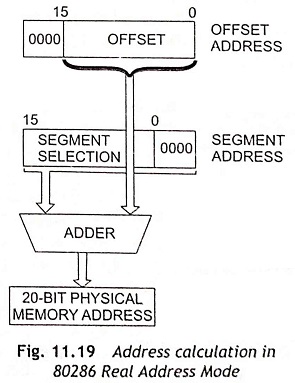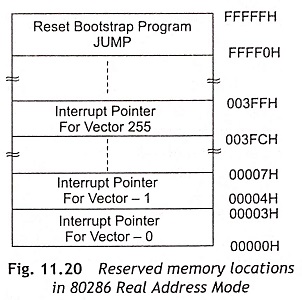Real Addressing Mode of 80286:
In the Real Addressing Mode of 80286 operation, 80286 executes a fully upward-compatible instruction of the 8086 instruction set. It works as a fast 8086. In Real Addressing Mode of 80286, the 80286’s object code is compatible with 8086 and 8088 software. In this addressing mode, the 80286 addresses a contiguous array of up to 1 M (1,048,576 bytes) of physical memory using A19-A0 and B̅H̅E̅. The lines A23-A20 should he ignored.
During addressing the physical memory of up to 1MB, the 80286 uses B̅H̅E̅ along with A19-A0 in the real address mode. The address bits A23-A20 will not be always zero in this mode. Hence A23-A20 should not be used by the processor when the 80286 operates in real address mode. The 20-bit physical address is generated in the same way as that in 8086. Figure 11.19 shows the address calculation in real address mode.
The segment selector portion of the pointer is used as the upper 16 bits of a 20-bit segment address. The lower four bits of the 20-bit segment address are always zero. Therefore, segment addresses begin on a multiple of 16 bytes. In this addressing mode, all segments are 64kB in size and may be read, written or executed. An exception or interrupt can occurs if data operands or instructions attempt to wrap around the end of a segment.
In real address mode, the 80286 reserves two fixed areas of memory, namely, system initialization area and interrupt table area. Memory locations from addresses FFFF0(H) to FFFFF(H) are reserved for system initialization. The memory location from 00000(H) through 0003FF(H) are reserved for interrupt vectors as depicted in Fig. 11.20.

